String capsule endoscopy for screening and surveillance of esophageal varices in patients with cirrhosis
- PMID: 23687586
- PMCID: PMC3655341
- DOI: 10.4161/jig.22173
String capsule endoscopy for screening and surveillance of esophageal varices in patients with cirrhosis
Abstract
Background: EGD is the gold standard for the screening and surveillance of esophageal varices. A less invasive, safer and sedationless alternative procedure is needed.
Objective: To assess the sensitivity, specificity, positive predictive value (PPV), negative predictive value (NPV) as well as the beyond the chance agreement (kappa index), of string capsule endoscopy (SCE) in the diagnosis of esophageal varices.
Methods: Cirrhotic patients underwent string capsule endoscopy (SCE) and EGD for screening and surveillance purposes. Varices were graded at EGD and SCE as small, medium and large. Descriptors at SCE were added as follows: PLUS, for the presence of red wale signs or, MINUS for their absence, irrespective of the estimated variceal size. Clinically significant varices were defined by their size (medium/large at either EGD or SCE) and/or, the PLUS descriptor irrespective of the estimated size at SCE. Sensitivity, specificity, PPV, NPV, accuracy and kappa index were calculated. Procedure time, procedure-related discomfort and patient's preference were documented.
Results: 100 patients (33 for screening and 67 for surveillance) were enrolled. The sensitivity and specificity of SCE for clinically significant varices when using the PLUS/MINUS descriptors were 82% and 90%, respectively with a PPV of 84% and NPV of 89% and a kappa of 0.73.
Conclusion: String capsule endoscopy had an acceptable sensitivity and specificity for the diagnosis of clinically significant esophageal varices but the lack of air insufflation still hampers its correlation with the grading used with EGD.
Keywords: cirrhosis; sensitivity; specificity; string capsule endoscopy; varices.
Figures


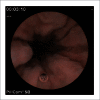
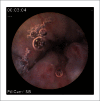
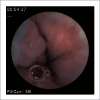
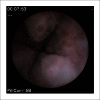
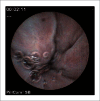
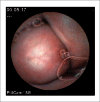

Similar articles
-
Esophageal capsule endoscopy for screening and surveillance of esophageal varices in patients with portal hypertension.Hepatology. 2008 May;47(5):1595-603. doi: 10.1002/hep.22227. Hepatology. 2008. PMID: 18435461
-
Feasibility and safety of string wireless capsule endoscopy in the diagnosis of esophageal varices.Am J Gastroenterol. 2005 May;100(5):1065-71. doi: 10.1111/j.1572-0241.2005.41037.x. Am J Gastroenterol. 2005. PMID: 15842580
-
Screening of esophageal varices in children using esophageal capsule endoscopy: a multicenter prospective study.Endoscopy. 2019 Jan;51(1):10-17. doi: 10.1055/a-0647-1709. Epub 2018 Sep 5. Endoscopy. 2019. PMID: 30184608 Clinical Trial.
-
Diagnosis and monitoring of portal hypertension.Dig Liver Dis. 2008 May;40(5):312-7. doi: 10.1016/j.dld.2007.12.007. Epub 2008 Feb 21. Dig Liver Dis. 2008. PMID: 18294933 Review.
-
Non-invasive (and minimally invasive) diagnosis of oesophageal varices.J Hepatol. 2008 Oct;49(4):520-7. doi: 10.1016/j.jhep.2008.07.009. Epub 2008 Jul 26. J Hepatol. 2008. PMID: 18706733 Review.
Cited by
-
Current and Future Use of Esophageal Capsule Endoscopy.Clin Endosc. 2018 Jul;51(4):317-322. doi: 10.5946/ce.2018.101. Epub 2018 Jul 31. Clin Endosc. 2018. PMID: 30078304 Free PMC article.
-
Use of Wireless Capsule Endoscopy for the Diagnosis and Grading of Esophageal Varices in Patients With Portal Hypertension: A Systematic Review and Meta-Analysis.J Clin Gastroenterol. 2017 Feb;51(2):174-182. doi: 10.1097/MCG.0000000000000589. J Clin Gastroenterol. 2017. PMID: 27548729 Free PMC article.
-
Capsule endoscopy for the diagnosis of oesophageal varices in people with chronic liver disease or portal vein thrombosis.Cochrane Database Syst Rev. 2014 Oct 1;2014(10):CD008760. doi: 10.1002/14651858.CD008760.pub2. Cochrane Database Syst Rev. 2014. PMID: 25271409 Free PMC article.
-
A novel method of cardia visualization and comfort level enhancement during magnetic capsule gastroscopy via sugar-glued tether-assisted technique: a randomized pilot study inspired by a Chinese snack-making process (with video).Surg Endosc. 2024 Nov;38(11):6948-6955. doi: 10.1007/s00464-024-11218-7. Epub 2024 Oct 3. Surg Endosc. 2024. PMID: 39361135 Clinical Trial.
-
Design and Evaluation of ScanCap: A Low-Cost, Reusable Tethered Capsule Endoscope with Blue-Green Illumination Imaging for Unsedated Screening and Early Detection of Barrett's Esophagus.Bioengineering (Basel). 2024 May 31;11(6):557. doi: 10.3390/bioengineering11060557. Bioengineering (Basel). 2024. PMID: 38927792 Free PMC article.
References
-
- Garcia-Tsao G, Sanyal AJ, Grace ND, Carey W. Practice Guidelines Committee of the American Association for the Study of Liver Diseases; Practice Parameters Committee of the American College of Gastroenterology. Prevention and management of gastroesophageal varices and variceal hemorrhage in cirrhosis. Hepatology. 2007;46:922–938. - PubMed
-
- Graham DY, Smith JL. The course of patients after variceal hemorrhage. Gastroenterology. 1981;80:800–809. - PubMed
-
- Sharara A I, Rockey DC. Gastroesophageal variceal hemorrhage. N Engl J Med. 2001;345:660–681. - PubMed
-
- Ramirez FC, Hakim S, Tharalson EM, Shaukat MS, Akins R. Feasibility and safety of string wireless capsule endoscopy in the diagnosis of esophageal varices. Am J Gastroenterol. 2005;100:1065–1071. - PubMed
-
- Ramirez FC, Shaukat MS, Young MA, Johnson DA, Akins R. Feasibility and safety of string wireless capsule endoscopy in the diagnosis of Barrett's esophagus. Gastrointest Endosc. 2005;61:741–746. - PubMed
LinkOut - more resources
Full Text Sources
